Understanding Positive Reinforcement
Definition and Basics
Positive reinforcement is a big deal in the world of behavioral psychology, especially when we’re talking about Applied Behavior Analysis (ABA) therapy. It’s like this: you add a something nice after someone does something right, and boom, they wanna do it again. The word “positive” here isn’t about being good (like good or bad), it’s just about adding something extra.
The basics of positive reinforcement boil down to a few key parts:
- Behavior: What someone does.
- Reinforcer: The thing they get after doing it.
- Increased Probability: They’re more likely to do it again because they liked the “thing.”
For moms and dads with kids who have autism, getting a grip on what positive reinforcement is can be a game-changer. It helps modify behavior, teaching new skills and promoting good vibes.
Forms of Positive Reinforcement
Positive reinforcement comes in all shapes and sizes, and it’s all about nudging the right behavior in the right way. Here’s a breakdown of some popular types:
- Natural Reinforcers: The good stuff comes directly from what you did. Like if a kiddo asks nicely for a toy, they get the toy. Instant win!
- Token Reinforcers: Collectible rewards. Think earning stickers for being awesome, and later swapping them out for something big and shiny.
- Social Reinforcers: Who doesn’t love a pat on the back? Smiles, high-fives, and kudos fall here. It’s like a little confetti shower of approval.
- Tangible Reinforcers: Goodies you can hold. Snacks, toys, or that special something you’ve had your eye on.
| Type of Reinforcer | Example |
| Natural Reinforcers | Getting the toy after asking nicely |
| Token Reinforcers | Stickers earned for good deeds |
| Social Reinforcers | A hearty “Well done!” or a big smile |
| Tangible Reinforcers | A special treat or new gizmo |
By mixing these kinds of positive reinforcement, parents can guide their little ones’ behavior in upbeat and rewarding ways.
Positive Reinforcement in Psychology
Principles and Effects
Positive reinforcement is like peanut butter to the jam of operant conditioning—a concept brought to life by B.F. Skinner. It’s all about rewarding good behavior with something enjoyable, making that behavior more likely to return for an encore performance.
Positive reinforcement is your cheerleader, shaping good habits by associating certain actions with something sweet. It’s a go-to strategy that’s handy in parenting, classrooms, or even working with kids with autism. Think of it as a toolkit where the tools are compliments, rewards, or extra freedom.
| Principle | Description |
| Positive Reinforcement | Using positive stimuli to encourage desired actions |
| Operant Conditioning | Learning process shaped by rewards and punishments |
| Reward Types | Compliments, goodies, and more time for fun |
Comparison with Negative Reinforcement
Now, don’t get negative reinforcement twisted with its positive sibling. Both want the same thing—more of those good behaviors—but they work different corners of the ring.
- Positive Reinforcement: Offer something nice after a good deed.
- Negative Reinforcement: Take away something annoying once the good deed is done.
| Type of Reinforcement | Method | Example |
| Positive Reinforcement | Add a pleasant element | Rewarding a treat for homework completion |
| Negative Reinforcement | Remove an irritant | Silencing a loud alarm when the kid wakes up |
While punishment relies on negativity to squash undesirable actions, positive reinforcement is like sunshine and rain—fostering a garden where good behaviors sprout and blossom. This approach is memorable, even when the reward doesn’t stay constant.
Teachers find positive reinforcement to be a goldmine in schools, improving students’ academic, emotional, and social lives. It’s a win-win, a simple yet potent way to steer classroom behavior while motivating learners. It’s like sneaking veggies into a favorite food—effective and hardly noticeable.
Practical Applications of Positive Reinforcement
Positive reinforcement—giving a goodie after someone does something right—is a surprisingly effective trick for getting people (or even animals) to do more of what you want. Think high-fives, chocolate bars, and nods of approval, all rolled into one strategy. This little piece of magic isn’t just for kids or pets—it’s happening in schools and jobs too!
Classroom Settings
Teachers know their way around with positive reinforcement—it’s like their superpower for keeping students on track. Imagine you’re back in school, and the teacher hands out shiny gold stars, compliments, or even an unexpected bit of candy when you ace a test. These are not just random acts of kindness; they work wonders. They don’t just control behavior—it boosts confidence and gives kids a reason to learn more (and maybe show off a bit!).
| Reinforcement Type | Example |
| Nice Words | “Amazing work on that science project!” |
| Star Stickers | A sticker book for aced quizzes |
| Small Stuff | An extra snack for teamwork |
| Extra Privileges | Longer breaks for being awesome in class |
These tiny gestures can light up a classroom. Research keeps on proving it: when kids feel encouraged, they tend to do better, whether it’s in making friends or acing their lessons.
Workplace Strategies
Positive reinforcement isn’t locked in the classroom. It sneaks into offices as well, where it can turn a case of the Mondays into a party. Imagine hitting your sales target and getting a sweet bonus or a shout-out at the company meeting. These little wins do a lot for a person’s mood and motivation.
Workplaces sprinkle positive vibes like this:
| Reinforcement Type | Example |
| Money Perks | Bonuses or a little bump in the paycheck |
| Cool Titles | Your photo on the “Star Employee” wall |
| Growth Opportunities | Paid courses or workshops |
| Fun Perks | More free time off or working from the beach |
Good bosses don’t just boss around—they spot when their team does something right and celebrate it. It lifts spirits and gets the wheels turning faster. Happy workers mean a happy company.
In classrooms and offices alike, positive reinforcement is barely a trick—it’s a lifestyle that makes learning, working, and everyday life a whole lot brighter. Clearly, it’s good stuff, and everyone wins!
Positive Reinforcement for Kids with Autism
Smart Ways to Use it
Positive reinforcement is like the good stuff in parenting tips, especially for kids on the autism spectrum. It’s all about making learning fun and boosting good behavior. Here’s how you can hit the sweet spot with positive reinforcement:
- Right Away is the Best Way: Give a thumbs-up or a treat right after the good stuff happens. Quick rewards help kids see the connection between what they did and the goodie they got.
- Keep it Regular: If you reward your kid, do it every time they do something you like. Scattershot rewards only confuse kids more and may lessen the impact.
- Mix it Up: Changing reward types keeps things exciting. It doesn’t always have to be sweets or toys; a hug or an extra ten minutes of their favorite video game could work wonders.
- Know What They Like: Every kid’s treasure chest is different. You’ll need to do some detective work to figure out what floats their boat.
- Break it Down: Take a big task and chop it up into bite-sized steps. Reward them for each little success, and before you know it, they’ll have nailed the whole shebang.
What You Get & What’s Tricky
Using positive reinforcement for kids with autism can bring a lot of good but also has its hiccups. Here’s the scoop:
What You Get:
- Better Communication: Rewards for trying to talk or use words help improve how kids express themselves (360 Behavioral Health).
- Learning New Stuff: With a bit of reward magic, kids can hit new milestones and pick up fresh skills.
- Less Bad Behavior: Good actions can start taking the place of not-so-good ones (Verywell Mind).
- Boosted Motivation: When the learning and behaving are fun, kids are all in, which keeps them keen on what’s next.
What’s Tricky:
- Keeping It Up: Staying on top of constant rewards can be tough, especially between home, school, and other places.
- Too Much of a Good Thing: Kids might start looking for rewards all the time instead of acting because it feels good inside.
- Finding the Gold: You might need to try out different rewards to see which ones work best for your kid and it’s often a work in progress.
- Timing is Everything: Give rewards too late, and they might miss why they’re being celebrated.
Master these tricks, and you can help your child tackle challenges with a little more ease and a lot more smiles.
Conclusion
In conclusion, positive reinforcement plays a crucial role in shaping a child’s behavior, especially in a familiar and supportive setting. In-home ABA therapy near me offers personalized strategies that help reinforce positive behaviors in real-life environments, making learning more effective. Explore local providers today to see how in-home ABA therapy can support your child’s growth and development.
Move Up ABA is Maryland’s trusted leader in ABA therapy, helping families master positive parenting through proven reinforcement strategies. Their expert team designs personalized programs that empower children to thrive while equipping parents with the tools to foster lasting behavioral success. Ready to create a more positive and supportive home environment? Contact Move Up ABA today and discover how their tailored approach can make a difference.
Frequently Asked Questions
What is positive reinforcement in parenting?
Positive reinforcement is a parenting technique that encourages desired behaviors by rewarding them with praise, attention, or other motivators to strengthen good habits.
How does positive reinforcement benefit children?
It helps build confidence, encourages good behavior, improves communication skills, and fosters a positive parent-child relationship by reinforcing desirable actions.
What are examples of positive reinforcement?
Examples include verbal praise (“Great job!”), small rewards like stickers or extra playtime, and social reinforcement such as high-fives or hugs.
Source:
- https://www.verywellmind.com/what-is-positive-reinforcement-2795412
- https://www.simplypsychology.org/positive-reinforcement.html
- https://www.commonwealthautism.org/teaching-outside-of-the-table/
- https://dictionary.apa.org/negative-reinforcement
- https://www.simplypsychology.org/positive-reinforcement.html




